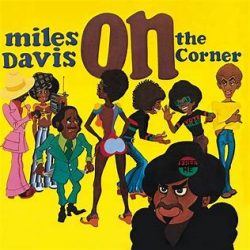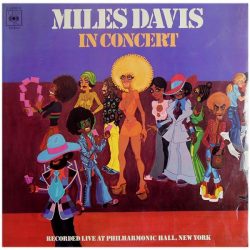
If you were a young music fan in the late ‘60s and early ‘70s there was every possibility that you would have heard of a lot more music and artists than you had managed to actually hear. That was certainly true of me as I started out on my lifelong obsession with music. In the early ‘70s the name Miles Davis was increasingly cropping up in the rock press of the time but his music hadn’t yet reached the North East of England. I got close when I bought a copy of John McLaughlin’s Mahavishnu Orchestra’s ‘Birds of Fire’ after watching them on a BBC 2 In Concert feature at the beginning of 1973. I was impressed enough that I decided I would dip my toe into the Miles Davis catalogue as McLaughlin had played such a large part in Davis’s move to jazz fusion. At the time the current Miles Davis album was ‘On The Corner’ which did get some promotion in the music press and had what I thought was a great cover based on Corky McCoy’s cartoons of ghetto inhabitants on a bright yellow background. The publicity said it and was supposed to be Davis’s take on the funk music of James Brown and Sly Stone.
 I dutifully got my copy and couldn’t wait to get home to give it a spin. When I did I was absolutely horrified at the cacophonous noise that was coming out of the speakers and that bore little or no relationship to anything I had heard before. What had I spent my money on and what had I missed out on by making this choice? I don’t remember reading any reviews before I bought ‘On The Corner’ but I subsequently found out that my shock and horror were shared by a number of reviewers from both the jazz and rock camps. Being an impecunious student meant I couldn’t afford to waste the money I had spent so I resolved, despite my better judgement, to force myself to persevere and try and understand the record, and what understanding was needed. The music had no melody to speak of, and was based on a one-chord modal approach, and was simply a series of rhythm tracks, there were no real solos only short snatches of the sound of solo instruments on the record. Individual instrumental voices were buried deep in the overall rhythmic mix and keyboard wash, and Miles himself was featured as much on keyboards as he was on trumpet. The original album cover didn’t include any musician credits because Davis wanted critics to concentrate on the music, not the musicians, and he was supposedly sick of his sidemen leaving for pastures new after being approached with tempting offers. Musicians who worked on their album have expressed their dislike of it, or at the very least, their lack of understanding of where Davis was going. It wasn’t just me then who was struggling to make sense of this new sound.
I dutifully got my copy and couldn’t wait to get home to give it a spin. When I did I was absolutely horrified at the cacophonous noise that was coming out of the speakers and that bore little or no relationship to anything I had heard before. What had I spent my money on and what had I missed out on by making this choice? I don’t remember reading any reviews before I bought ‘On The Corner’ but I subsequently found out that my shock and horror were shared by a number of reviewers from both the jazz and rock camps. Being an impecunious student meant I couldn’t afford to waste the money I had spent so I resolved, despite my better judgement, to force myself to persevere and try and understand the record, and what understanding was needed. The music had no melody to speak of, and was based on a one-chord modal approach, and was simply a series of rhythm tracks, there were no real solos only short snatches of the sound of solo instruments on the record. Individual instrumental voices were buried deep in the overall rhythmic mix and keyboard wash, and Miles himself was featured as much on keyboards as he was on trumpet. The original album cover didn’t include any musician credits because Davis wanted critics to concentrate on the music, not the musicians, and he was supposedly sick of his sidemen leaving for pastures new after being approached with tempting offers. Musicians who worked on their album have expressed their dislike of it, or at the very least, their lack of understanding of where Davis was going. It wasn’t just me then who was struggling to make sense of this new sound.
Eventually, my determination paid off, and I eventually found a coherence to the circular rhythms and I got some comfort in their repetitive ebb and flow. Once I started finding some affinity with the music, I resolved to understand where Davis was coming from when he recorded it. Davis believed he had made a genuine attempt to move his music towards a younger  black audience, away from the predominantly white hippie audience his jazz rock excursions had won him up to that point. I subsequently found out that none of the musicians who worked on the recording knew completely where Davis was coming from, and this included Paul Buckmaster the celebrated British arranger who had introduced him to the music of classical composer Karlheinz Stockhausen, and whose pioneer use of electronics had a major influence on ‘On The Corner’ as did Bach. Additional influences included Indian modal music represented by Badal Roy on tabla and Khalil Balakrishna on electric sitar who were introduced to Davis by John McLaughlin and first appeared on ‘Bitches Brew’ after he had heard Badal Roy playing in a New York Indian restaurant. ‘On The Corner’ also marked the point in his career when Miles Davis finally acknowledged Ornette Coleman’s Harmolodics musical theory, which was used by Coleman for his own electric funk explorations. The album was compiled by Davis’s producer Teo Macero by his use of innovative physical tape splicing using the many jams and performances directed by Davis. Many contemporary critics thought the music incapable of being played live due to the way it was recorded, but Davis’s live shows at the time provide this assumption to be wrong. Give 1973’s ‘In Concert’, which has its own Corky McCoy cover, for clear proof of the power of Davis’s band’s live capability.
black audience, away from the predominantly white hippie audience his jazz rock excursions had won him up to that point. I subsequently found out that none of the musicians who worked on the recording knew completely where Davis was coming from, and this included Paul Buckmaster the celebrated British arranger who had introduced him to the music of classical composer Karlheinz Stockhausen, and whose pioneer use of electronics had a major influence on ‘On The Corner’ as did Bach. Additional influences included Indian modal music represented by Badal Roy on tabla and Khalil Balakrishna on electric sitar who were introduced to Davis by John McLaughlin and first appeared on ‘Bitches Brew’ after he had heard Badal Roy playing in a New York Indian restaurant. ‘On The Corner’ also marked the point in his career when Miles Davis finally acknowledged Ornette Coleman’s Harmolodics musical theory, which was used by Coleman for his own electric funk explorations. The album was compiled by Davis’s producer Teo Macero by his use of innovative physical tape splicing using the many jams and performances directed by Davis. Many contemporary critics thought the music incapable of being played live due to the way it was recorded, but Davis’s live shows at the time provide this assumption to be wrong. Give 1973’s ‘In Concert’, which has its own Corky McCoy cover, for clear proof of the power of Davis’s band’s live capability.
When it was released, ‘On The Corner’ was not the commercial success Davis was hoping for, nor did it particularly break through to a younger black audience at the time of its release. It was also the last studio album recorded as a whole until Davis’s comeback in the ‘80s, with subsequent ‘70s releases being live albums or studio records compiled from various disparate recording sessions. For me, the album made me a lifelong fan of Miles Davis and I subsequently explored all phases of his career, it also enabled me to explore the wider jazz world away from the fusion of the ‘70s. It also proved to be a musical education for me, making me aware of non-western and world music, as well as the work of the avant-garde classical composers. While the commercial sales and reviews at the time were disappointing, ‘On The Corner’ has subsequently proved to be one of Miles Davis’s most influential recordings influencing such subsequent musical trends as funk, rock, hip hop, dance, ambient, electronic and world music. That isn’t to say that despite its belated acclaim it is an easy listen, it certainly doesn’t fit in with anyone’s idea of a Saturday night or a Sunday morning record. A personal example of this is that back in the pre-CD day I had to make numerous cassette recordings of it for the car because if I ever played it when my wife was in the car it was invariably thrown out of the window with the refrain “It is those bin lids again, I know you can’t enjoy listening to it and you are just playing it to wind me up”. Final rehabilitation was achieved when in 2007 Columbia Records released ‘The Complete On The Corner Sessions’ with over three hours on unreleased music.



Great analysis Martin. It’s one of his most challenging albums but, as you say, rewards perseverance.
Thanks Rick, it did permanently help change my understanding of music.